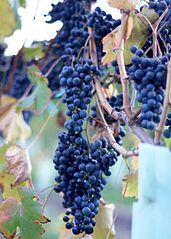Lagrein
| Lagrein | |
|---|---|
| Synonyms | Burgundi Lagrein, Lagrain, Lagrain Blauer, Lagrein Kretzer, Lagrino, Lagroin - for more see the Synonyms section |

|
|
| Art | Grape vine ( Vitis vinifera subsp. Vinifera ) |
| Berry color | Brown black |
| use | |
| origin | Italy |
| known since | 1525 |
| VIVC no. | 6666 |
| ancestry | |
| List of grape varieties | |
Lagrein is a red wine that comes from South Tyrol and is mainly cultivated there. It is used to make rosé and red wines : the rosé wines are called Lagrein Kretzer or Lagrein Rosato, the red wines are called Lagrein Dunkel or Lagrein scuro, and recently they are simply Lagrein. Lagrein usually makes strong, dark and characterful red wines.
Descent and origin
Lagrein is a natural cross of Vernatsch × Teroldego from Italy.
Until the 18th century, “Lagrein” usually meant the White Lagrein, which was probably the most important South Tyrolean variety from the Middle Ages to modern times. Testified for the first time the "bonum Lagrinum" (good Lagreinwein) is in a Traminer charter of 1379 , while Bolzano sources from 1420 to lägrein wine and in 1498 the grades of white Lagrein explicitly call. The Rote Lagrein is also mentioned in Michael Gaismair's state regulations around 1525:
"[...] and the desolate vineyards should be made into glazes, put on red lagrein darynnes and rejured make wine like in the wälschland [...]"
Lagrein has only been generally understood as the red variety since the 20th century.
Ampelographic features
- The tip of the shoot is hairy green and tomentose.
- The drooping shoot and the stinginess is very strong.
- The leaf is medium to large in size, three to five lobes and not very indented.
- There are two types of grapes:
- long-stemmed type: grapes are larger and looser; very fertile and the
- short-stemmed: grapes smaller, less fertile and ripen earlier
- The berries are medium-sized, brown-black in color and have a hard berry skin. The pulp is juicy and has a fruity taste.
Maturity: late
Yield
Depending on the type of grape, the yields are medium to high. For good wine quality, balanced growth and well-exposed grapes are a prerequisite.
Properties, claims
- The good winter frost resistance is advantageous. The tendency to stalks and grape wilts is low.
- The disadvantage is the susceptibility to vine leafhopper and the high susceptibility to oidium and downy mildew . Because of the hanging development of the shoots, early tacking is necessary. The frequent foliage work in the grape zone to cut out the grapes causes more work. Heavy soils rich in humus are unsuitable. They reinforce the already strong growth.
- The variety makes high demands on location, as it is very warmth-loving.
- The variety finds good conditions in the warm Bolzano valley basin on river gravel soils.
distribution
The worldwide cultivation area in 2010 is 718 ha. Of this, 654 ha in Italy and 64 ha in the USA.
Italy - South Tyrol

The variety was grown in South Tyrol in 2018 on an area of 476 hectares. The locations around the Gries district of Bolzano are particularly well-known, and have dwindled significantly over the past 100 years due to urban expansion.
Wine
Lagrein brings very dense, dark, tannin-rich wines with a distinctive tannin structure. High quality wines are mainly made on vines with moderate growth. The wine is well suited for aging in wooden barrels.
Synonyms
Historical synonyms: Burgundi Lagrein, Lagrain, Lagrain Blauer, Lagrein Kretzer , Lagrino, Lagroin.
See also
Web links
literature
- Karl Bauer, Ferdinand Regner , Barbara Friedrich: Weinbau , avBuch im Cadmos Verlag, Vienna, 9th edition 2013, ISBN 978-3-7040-2284-4 .
- Pierre Galet : Dictionnaire encyclopédique des cépages . 1st edition. Hachette Livre, 2000, ISBN 2-01-236331-8 .
Individual evidence
- ↑ The SSR-based molecular profile of 1005 grapevine (Vitis vinifera L.) accessions uncovers new synonymy and parentages, and reveals a large admixture amongst varieties of different geographic origin , by Guido Cipriani, Alessandro Spadotto, Irena Jurman, Gabriele Di Gaspero, Manna Crespan, Stefano Meneghetti, Enrica Frare, Rita Vignani, Mauro Cresti, Michele Morgante, Mario Pezzotti, Enrico Pe, Alberto Policriti, RaVaele Testolin, published in Theoretical and Applied Genetics , Vol. 121, No. 8, pp. 1569–1585, Released August 6, 2010.
- ^ Schneider, Walther: The land register of the Heilig-Geist-Spital in Bozen from 1420 . Innsbruck: Universitätsverlag Wagner 2003, p. 118 No. 355. ISBN 3-7030-0381-2
- ^ Hannes Obermair : Bozen Süd - Bolzano Nord. Written form and documentary tradition of the city of Bozen up to 1500 . Bozen: City of Bozen, 2 volumes, 2005–2008. Vol. 1, No. 833 and Vol. 2, No. 1330 - Zwerger, Roland: From the Weißen Lagrein over the 'Weißterlinger' to the Gewürztraminer. A short history of South Tyrolean varieties with a special focus on Tramin . In: « Der Schlern » 79/2005, issue 8/9, p. 83
- ↑ Politi, Giorgio: Gli statuti impossibili: la rivoluzione tirolese del 1525 e il 'program' di Michael Gaismair . Torino: Einaudi 1995, p. 328.
- ↑ a b Karl Bauer, Ferdinand Regner , Barbara Friedrich: Weinbau , avBuch im Cadmos Verlag, Vienna, 9th edition 2013, ISBN 978-3-7040-2284-4 .
- ↑ K. Anderson, NR Aryal: Database of Regional, National and Global Winegrape Bearing Areas by Variety, 2000 and 2010. Wine Economics Research Center, University of Adelaide, December 2013 (first revision April 2014) (second revision May 2014) (third Revision July 2014).
- ↑ Bozen Chamber of Commerce , statistics
- ↑ accessed on January 15, 2017 Lagrein in the database Vitis International Variety Catalog of the Institute for Grapevine Breeding Geilweilerhof (English)